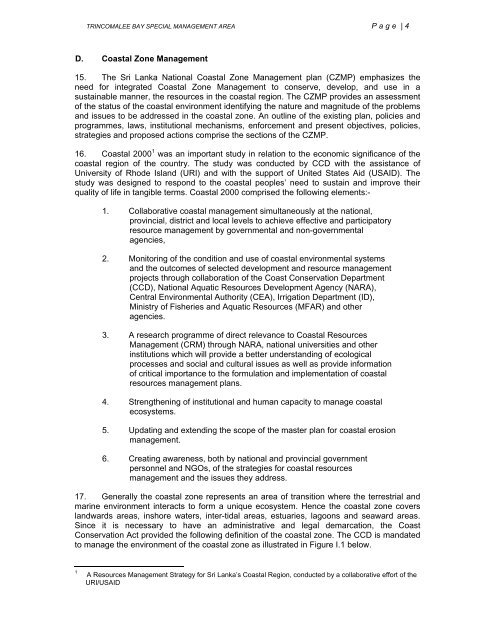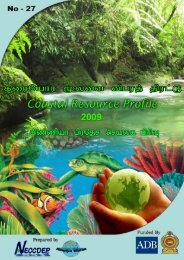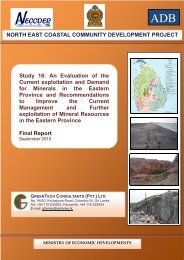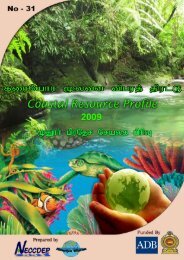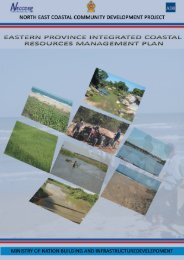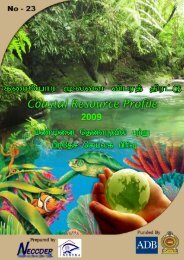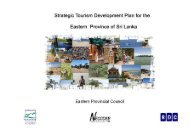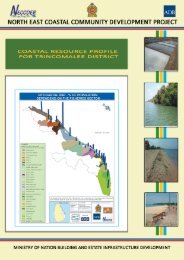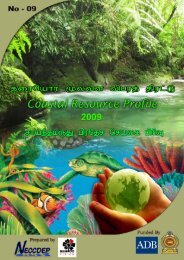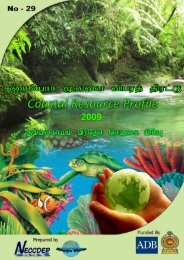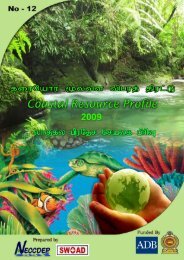Untitled - Neccdep.com
Untitled - Neccdep.com
Untitled - Neccdep.com
You also want an ePaper? Increase the reach of your titles
YUMPU automatically turns print PDFs into web optimized ePapers that Google loves.
TRINCOMALEE BAY SPECIAL MANAGEMENT AREA Page | 4<br />
D. Coastal Zone Management<br />
15. The Sri Lanka National Coastal Zone Management plan (CZMP) emphasizes the<br />
need for integrated Coastal Zone Management to conserve, develop, and use in a<br />
sustainable manner, the resources in the coastal region. The CZMP provides an assessment<br />
of the status of the coastal environment identifying the nature and magnitude of the problems<br />
and issues to be addressed in the coastal zone. An outline of the existing plan, policies and<br />
programmes, laws, institutional mechanisms, enforcement and present objectives, policies,<br />
strategies and proposed actions <strong>com</strong>prise the sections of the CZMP.<br />
16. Coastal 2000 1 was an important study in relation to the economic significance of the<br />
coastal region of the country. The study was conducted by CCD with the assistance of<br />
University of Rhode Island (URI) and with the support of United States Aid (USAID). The<br />
study was designed to respond to the coastal peoples’ need to sustain and improve their<br />
quality of life in tangible terms. Coastal 2000 <strong>com</strong>prised the following elements:-<br />
1. Collaborative coastal management simultaneously at the national,<br />
provincial, district and local levels to achieve effective and participatory<br />
resource management by governmental and non-governmental<br />
agencies,<br />
2. Monitoring of the condition and use of coastal environmental systems<br />
and the out<strong>com</strong>es of selected development and resource management<br />
projects through collaboration of the Coast Conservation Department<br />
(CCD), National Aquatic Resources Development Agency (NARA),<br />
Central Environmental Authority (CEA), Irrigation Department (ID),<br />
Ministry of Fisheries and Aquatic Resources (MFAR) and other<br />
agencies.<br />
3. A research programme of direct relevance to Coastal Resources<br />
Management (CRM) through NARA, national universities and other<br />
institutions which will provide a better understanding of ecological<br />
processes and social and cultural issues as well as provide information<br />
of critical importance to the formulation and implementation of coastal<br />
resources management plans.<br />
4. Strengthening of institutional and human capacity to manage coastal<br />
ecosystems.<br />
5. Updating and extending the scope of the master plan for coastal erosion<br />
management.<br />
6. Creating awareness, both by national and provincial government<br />
personnel and NGOs, of the strategies for coastal resources<br />
management and the issues they address.<br />
17. Generally the coastal zone represents an area of transition where the terrestrial and<br />
marine environment interacts to form a unique ecosystem. Hence the coastal zone covers<br />
landwards areas, inshore waters, inter-tidal areas, estuaries, lagoons and seaward areas.<br />
Since it is necessary to have an administrative and legal demarcation, the Coast<br />
Conservation Act provided the following definition of the coastal zone. The CCD is mandated<br />
to manage the environment of the coastal zone as illustrated in Figure I.1 below.<br />
1<br />
A Resources Management Strategy for Sri Lanka’s Coastal Region, conducted by a collaborative effort of the<br />
URI/USAID


